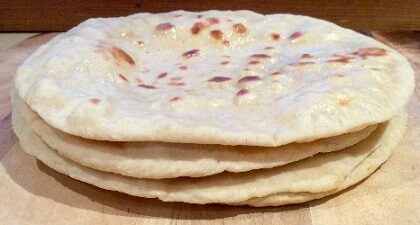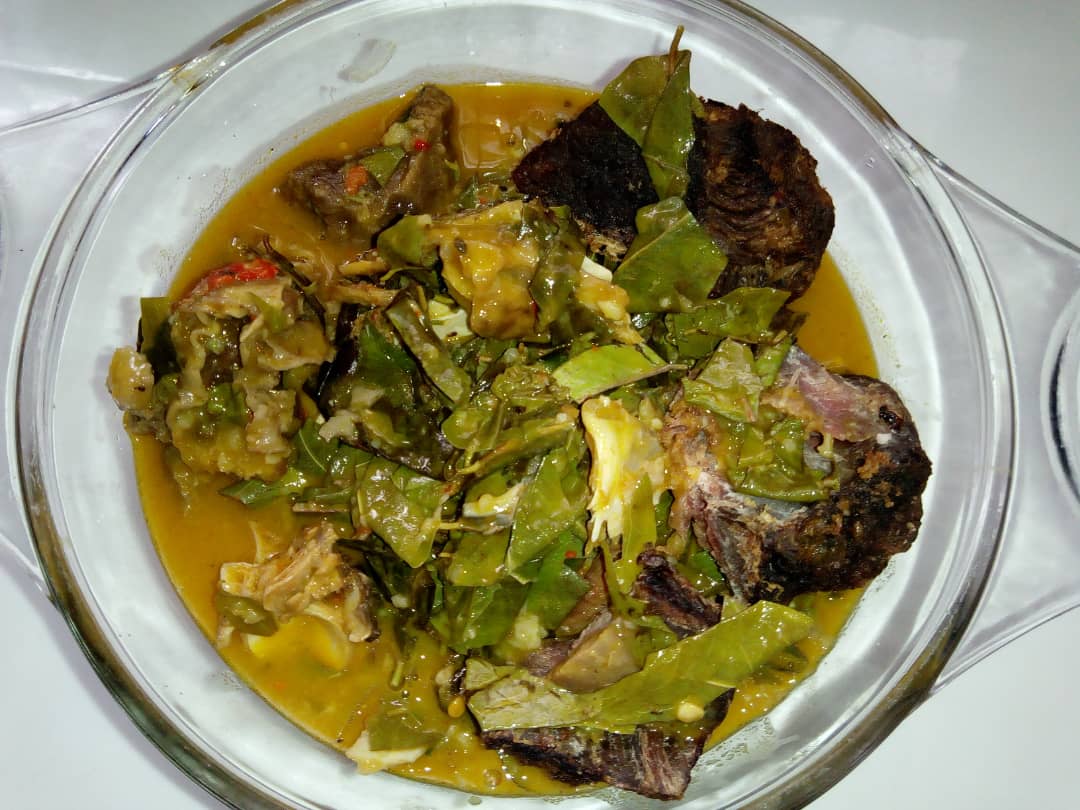
Ayaraya oka also called Otipiri is a highly nutritious delicacy that is rich in protein and fiber. Ayaraya Oka is a native Igbo food that is special among the people of Udi and Nsukka of Enugu State; and other South East State of Nigeria also enjoy this unique dish.
Basically, Ayaraya Oka or Otipiri is made from a rough blend of maize, pigeon pea (Agbugbu local beans), fermented oil bean seed locally called Ugba, palm oil, onion, vegetables, and salt.
There are different kinds of Otipiri/ Ayaraya recipe, we have Ayaraya Oka made from corn, then the Ayaraya Ede recipe is made from cocoyam, and Ayaraya Ji is prepared with yam.
Agbugbu also called pigeon pea or fio-fiois a good source of protein it has fiber, potassium, iron, and low in calories and fat.
Homemade Otipiri recipe is a tasty and delicious dish when properly cooked, though demanding and time-consuming but you will love this food. Otipiri food is a healthy diet that can be eaten even among diabetic patients, and it will not increase their blood sugar level.
Ayaraya Oka Wikipedia
Pigeon pea, or Cajanus cajan, is a perennial legume in the Fabaceae family.
Types of Ayaraya
- Ayaraya Oka (Pigeon peas and corn).
- Ayaraya Ede (Pigeon peas and dried cocoyam)
- Ayaraya Ji (Pigeon peas and yam)
Ayaraya oka benefits – Health Benefits of Fio-Fio (Pigeon Peas) to the Body
Legumes which include pigeon peas, are extremely healthy for the body. They are nutrient-dense and provide a healthy energy boost without triggering weight gain or fat accumulation.
Help Build bones and muscles
One cup of cooked pigeon peas has eleven grams of protein in it. Protein is necessary for the body’s growth and development. Protein makes up bones, muscles, tissues, and cells.
Good for Diabetes Person
Diabetics can consume pigeon peas since they have a low glycemic index. According to research, pigeon pea extract decreases blood glucose levels in diabetic rats when they are fasting.
Lowers Blood Pressure
Potassium, which is present in pigeon peas, helps to relax blood vessels and lower blood pressure. It is a vasodilator, which means it relaxes blood vessels.
Anti-inflammatory Properties
Pigeon peas also have anti-inflammatory properties within the body. Certain chemical compounds found in pigeon peas help reduce inflammation and edema in the body.
Traditional remedies for hemorrhoids also included a paste made from crushed pigeon peas.
Aids weight loss
Pigeon peas help people lose weight, because they contain fiber, they immediately make you feel fuller and less hungry.
Anaemia
Since pigeon peas can help prevent anemia, they are beneficial to your health. A condition known as anemia occurs when the blood does not contain enough healthy red blood cells.
- Prevents starvation
- Reduces cramping
- It makes bowel movements easier.
- It is a worm expeller
- Prevent stomach ulcers
- For those who have sickle cell anemia, it is beneficial.
- It minimizes nausea
- Used in the treatment of UTIs as well
- Its leaves can be used to clean teeth.
- It also cures yellow fever.
- Leaves possess antimalarial properties.
- Possesses anticancer properties
- Its leaves can be used to cure hepatitis.
What is achicha made from? Igbo Food Achicha
A traditional meal from the Igbo region of Nigeria, Ẹchịcha (also known as Achịcha) is mostly made of dried cocoyam, mgbụmgbụ (pigeon pea), and palm oil.
It is traditionally consumed during the dry season, when it is difficult to find fresh veggies.
How to make Ayaraya Oka Recipe – Otipiri Recipe
Ingredients
- Maize – Oka/ Corn soaked Over-night ( Rough blend)
- Beans -Agbugbu (Local beans/fio fio – dry Pigeon peas)
- Vegetables ( Spinach and Scent leaf)
- Anyara leaf and Seed (or Bitter leaf)
- Fresh Akidi (Optional)
- palm oil
- Pepper
- Onion
- Ugba -Ukpaka ( African oil bean)
- Seasoning cube (optional)
- Salt to taste
Method of preparation
- First of all, pre-soak your Oka/corn/Maize overnight, the next day rinse and roughly ground and set aside.
- Secondly, pick out dirt from the Fio Fio/pigeon peas/ local beans/Agbugbu, wash, place in a clean pot and cook to soften. Similarly, you can soak overnight and cook the next day, it saves cooking time.
- Note: Method 1-While the bean is on fire, pour the grinded corn into a nylon bag ensure you double the nylon. Place it inside the boiling beans as they both cook together; do it in a way water will not enter into the corn.
- Method 2- When the Agbugbu/bean is almost done, reduce excess water from the beans to be of the same level. Add your already washed bitter leaves over the beans to cover properly. Thereafter, in a basket or iron sieve pour the grinded maize and place it over the bitter leaf; and allowing cooking for like 1 hour or more.
- Thirdly, the maize needs steam to cook not necessarily water; when the grinded corn is done, also check the fiofio.
- Fourthly, Wash and slice the scent leaf and anyara leaf keep aside; wash and slice the onion, grate the fresh pepper.
- Finally, in a clean pot heat the palm oil, stir in the onions; stir fry for some minutes, add pepper, Ugba/Ukpaka (oil bean), crayfish. Stir fry for few minutes and add little quantity of water; cover the lid and allow boiling for like 3-5 minutes.
- the next step is to add the maize stir properly, then fiofio, scent leaf, and anyara leaf mix to combine very well; taste for salt and adjust seasoning cover to heat for 3 minutes.
- At this point your original Otipiri, Ayaraya Oka/Maize vegetable recipe is ready.
Serve hot and enjoy!
Nutritional Value of Pigeon Peas (Fio-Fio)
Pigeon peas are good sources of fiber, protein, and other vitamins and minerals like magnesium, copper, manganese, thiamine, phosphorus, and potassium.
They have low-fat content and contain antioxidants that protect the body against free radicals.
One cup (168 grams) of cooked pigeon peas contains:
- Energy: 850 kilojoules (203 calories)
- Protein: 11 grams (g)
- Fat: 0.6 g
- Carbs: 39 g
- Fiber: 11 g
- Potassium: 645 milligrams (mg)
- Calcium: 7% of Daily Value (DV)
- Magnesium: 22% of DV
- Iron: 22% of DV
- Zinc: 14% of DV
- Phosphorus: 28% of DV
- Manganese: 34% of DV
- Selenium: 8% of DV
- Copper: 50% of DV
- Folate: 46% of DV
- Riboflavin: 6% of DV
- Thiamin: 22% of DV
Side Effects of Ayaraya Pigeon Peas
Pigeon peas, also known as toor dal or Cajanus cajan, are a nutritious legume commonly consumed in various cuisines.
While they offer numerous health benefits due to their high protein, fiber, and micronutrient content, it’s essential to note that individuals with certain dietary restrictions or medical conditions may experience side effects.
Pigeon peas include oligosaccharides, which are indigestible carbohydrates that can cause bloating and discomfort on some individuals.
These effects can be reduced by soaking the pigeon peas before boiling them and removing the water when you per boil before cooking to tender.
Some people may be sensitive to legumes, leading to digestive issues such as bloating or gas. Additionally, pigeon peas contain purines, substances that can be problematic for individuals with gout as they may contribute to uric acid buildup. As with any food, moderation is key.


